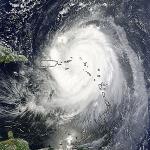31 August 2010

Photo: AP
A NASA image shows Hurricane Earl - now a powerful Category 4 storm - as it passes over the Leeward Islands and barrels toward the US coast, 31 Aug 2010
Weather officials said Hurricane Earl was moving northward off the U.S. coast, after skirting parts of the eastern Caribbean this week, and that residents in low-lying areas should be prepared to evacuate if needed.
Forecasters at the National Hurricane Center in Miami said they are closely watching the storm for signs that it will remain in open waters, or turn west and impact the U.S. coastline. They said the outer fringes of the category four storm are expected to reach the barrier islands of North Carolina by Friday.
National Hurricane Center Director Bill Reed said the storm should continue to produce very dangerous conditions in Atlantic waters as it moves north.
"We are going to have an impact in the way of dangerous swells and surf, rip currents and beach erosion as the storm moves up the coast," said Reed. "Even a minor shift back to the west could bring direct impacts to portions of the coastline from the mid-Atlantic northward."
Emergency officials said residents in low-lying coastal areas from North Carolina to Maine should be prepared for possible evacuations in coming days. They said residents should monitor local weather officials, who may begin issuing storm warnings as Earl moves closer to the U.S. mainland.
Federal Emergency Management Agency Administrator Craig Fugate said the main concern is possible flooding.
"The primary threat here is going to be storm surge. We use tropical force winds, however, as a benchmark to have an evacuation completed because many of the overland routes will include high bridges and other things that tropical force winds make it extremely dangerous," said Fugate.
Earlier, heavy rains from Earl caused flooding in low-lying areas of Antigua, and winds ripped out trees and blew down power lines on the nearby island of St. Martin. Officials in the U.S. Virgin Islands and Puerto Rico said they are working to restore electricity to more than 200,000 people who were affected by the storm.
Meanwhile, forecasters said residents of the eastern Caribbean should prepare for possible impact from another storm that has formed in the Atlantic. Tropical Storm Fiona is expected to reach parts of the area by Wednesday.
Bill Reed of the National Hurricane Center says Fiona is not expected to come as close to land as Earl did.
"It is forecast to remain northeast of the islands and not impact the U.S. Virgin Islands and Puerto Rico in the same places that were hit by Earl. It is running parallel to Earl and off to the east, maybe impacting Bermuda by the weekend," said Reed.
Current forecasts show Fiona moving north on a path that will keep it far off the U.S. East Coast.